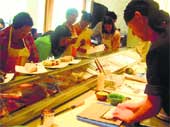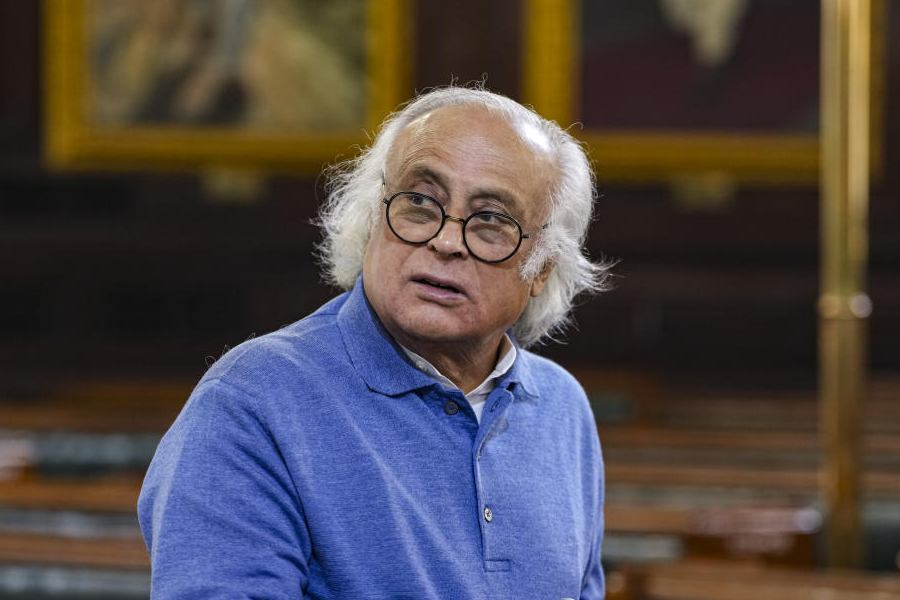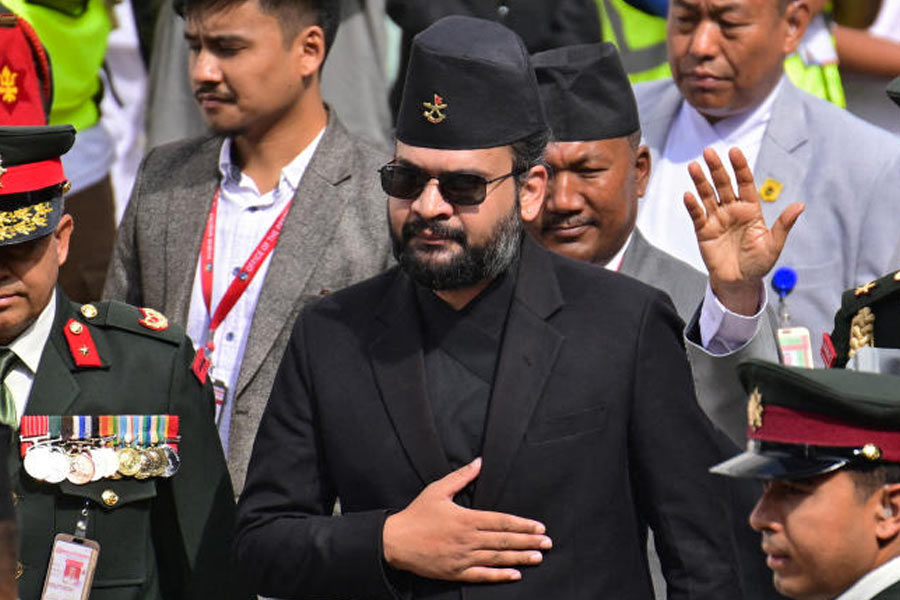 |
| A coookery workshop in progress at the Shangri-La’s 19 Oriental Avenue |
Can you get the batter just right for a tempura? And can you whip up a lip-smacking Bolognese sauce that will go just right with the perfectly cooked penne pasta? And how about a French sauce to go with your succulent grilled steak? If all that’s not enough, how about making an onigiri (salted rice balls warped in nori seaweed) to pair with sushi, the Japanese way?
Surely you know how to make all these delicacies from different corners of the world? And, if you have guests, certainly you aren’t feeding them with the same old biryanis or butter chicken that Indian housewives have dished out since time immemorial? It’s time to do better than that, so what cuisine will it be for your next soirée — Japanese, Thai, or just plain old Italian?
Take travel agent Rati Shroff for instance, who was determined to get her desserts just right. She travelled all the way to Vienna for lessons on how to make Apple Strudel and other Viennese-style specialities. “It comes in handy to know exotic cooking,” says Shroff, who says that she believes in “feeding guests from my hands”.
Or, look at industrialist wife Sonali Punj who has been for Cordon Bleu classes in London and regularly uses the skills she has learnt. She often makes dishes like a steak the way the French would recognise it — and not just when guests are coming home. Similarly, Sonu Wassan, wife of former cricketer and businessman Atul Wassan, makes sure she’s in the kitchen when anyone special is coming. “I love to cook,” says Sonu, whose menu could be anything from Mughlai food to special Italian dishes.
Remember the days when Indians famously only wanted desi khana? They went pale when confronted by anything as foreign as a pasta and became positively nauseous if faced with something like sushi (‘isn’t that raw fish?’ would be their first reaction).
That era’s over and the adventurous Indian is now guzzling it down with the best of them in the smart new restaurants that are coming up all over town. But you don’t necessarily have to eat out to get these foreign delicacies. The smarter hostess is serving up exotic food these days — at home.
 |
| Alan Bird of The Ivy in London |
Partly it’s a question of keeping up with the Joneses (and the Singhs and Chatterjees). But learning exotic cooking is all the rage. “Partly, it’s to impress guests. When people entertain guests, they want something new. And the trick now is to feed guests with ‘exotic’ home-cooked food and avoid ordering from outside,” says Chef Sanjeev Kapoor of Khana Khazana fame.
Ramesh Javvaji, executive chef at ITC Sonar Bangla has always been quick to spot people’s interests and encourages his team to nurture this. That’s why Chef Suniti Mittal who presides over ITC’s West View Bar and Grill held a basic Italian cooking workshop earlier this year. Mittal was selective about her pupils so she spread the word among her regulars. The result was that eight ladies signed up for it. Mittal was determined to keep it small and she gave each one instructions on recipes and written modules that went along with the actual class.
Mittal focused on the essentials of Italian cooking and covered subjects like making pasta from scratch and also making the pasta sauces (pomodoro, pesto, aglio olio pepperochino & cream cheese sauce) to go with them. Then, she covered the herbs needed like (basil, parley, thyme) and the cheeses that go with different kinds of pasta (Mozarella and Parmesan). But Mittal made sure she didn’t stop at the theoretical level — she also discussed where to get the more unusual ingredients like herbs and puccini mushrooms. The cost was Rs 850 but that included lunch and a gift hamper
But Italian isn’t at the top of the menu card these days for wives who want to be smart hostesses. It has been overtaken by the cuisine that once had Indians quailing. That’s Japanese. Cashing in on this is the Nikko Hotel in Delhi where Chef Nariyoshi Nakamura will be holding a class on making sushi next month. “We plan to have at least 25”, says Ravi Prakash Singh, restaurant manager, Sakura.
Another of Delhi’s newer hotels, the Shangri-La, is also keen to display its skills at anything Oriental. It will be holding classes in Japanese, Thai and even Chinese cuisine. But the star, says Amit Oberoi, resident manager, Shangri-La Hotel, is undoubtedly the cuisine from the Land of the Rising Sun. “Japanese cuisine is fast catching up as a hot favourite among Indians. Also Japanese food is a status symbol, so we cater to the needs of people who want to explore this cuisine”
It’s much the same story at The Oberoi, which general manager Devendra Bharma says has held Italian and Japanese (and also Indian) cuisine classes. But Chef Augusto Cabrera who’s in charge of the sushi kitchen makes sure that everyone knows how to get hold of the ingredients. Where, for instance, do you get the sumeshi (sushi rice) and which supplier will come with tuna, salmon, red snapper, kettle fish and also the pungent wasabi paste and powder.
Even in Calcutta, which has been slightly behind Delhi and Mumbai when it comes to food trends, there’s a lot of enthusiasm for Oriental cuisines. That’s why the Pan Asian held a session on Japanese and Tepenyaki food which turned out to be a big hit. There was also a sushi workshop by chefs Pramod Sinha and Wichien Putha where the basics of sushi were demonstrated. The emphasis was on vegetarian sushi and the rolls comprised avocado, cucumber, mayonnaise, horseradish pickle and the ABCs of making a basic wasabi sauce. There are plans to repeat these classes in the near future.
 |
| Rano Suri in the midst of a cookery class |
But there are other places outside the five stars to learn exotic cuisine. Take a look at Delhi-based Rano Suri, foodie and author of five cookbooks. She started several years ago but has steadily upgraded and is serving up more exotic dishes for her students nowadays. Today Suri, who has no formal training, is running 13 different types of classes — Mexican, Italian, Thai, Lebanese. She even instructs some pupils on how to make cocktails. She says that all types of people (mostly women) turn up for her classes. “It’s not just young brides to be who learn instant cooking. It’s an entire brigade of society ladies who now want to learn exotic cooking,” says Suri.
 |
| Nita Mehta and a student at the Nita Mehta Culinary Academy in Delhi’s GK II |
It’s the same story for another Delhi-based expert Nita Mehta who runs the eponymous Nita Mehta Culinary Academy and who is now teaching everything from multi-cuisine to making low- calorie food.
And for those who want to make a holiday of it, there’s Tanny Baig, the author of 16 cookbooks. She’s planning to teach exotic cooking at her six-bedroom guesthouse in Nathuakhan about 40 minutes from Ramgarh. “It will be very exclusive cooking in Thai and other Continental dishes,” she says.
 |
| Chef Sanjeev Kapoor in action during a cook-out |
Sanjeev Kapoor was one of the first chefs to share his secrets with the public at large. Today he has moved on and holds classes only for his own staff and if he gets special requests from corporate houses. Kapoor, who’s an expert on Indian tastes and food fads reckons that Mexican and Italian are probably the most popular cuisines with middle-class Indian (even if Japanese is the most fashionable). Also, Kapoor insists it’s all about innnovation. “People may like to grill chicken with blackberry. This is basic cooking. This is not Italian or French.”
And of course, learning the art of global cuisine comes with a price. Private institutes like Suri’s costs Rs 1,000 per course which includes four to six classes where one can learn 14 to 16 dishes. While at the five-stars, the cost per session (which lasts from five to six hours) is anything from Rs 1,200 to Rs 2,500 plus taxes, followed usually by a four-course meal.
Bill Marchetti at the Maurya Sheraton has also held several Italian food classes in the last two or three years. And the hotel has gone one further and flown down celebrity chefs from places like London for special sessions. One such chef was Alan Bird of the popular London restaurant, The Ivy who interacted with guests. Similarly, Anna Tasca Lanza of The Tasca d’ Almerita Winery in Sicily, taught the finer art of preparing Italian food. But Marchetti has a warning for newcomers who think Italian food is easy. “It’s easy to prepare. But sometimes the simplest foods are the hardest.”
One man who’s thinking even further is Calcutta’s Pradip Rozario. He has a tie-up with an Australian organisation, the International College of Culinary Arts, and is about to kick-start a course that will be spread over two 23-week long semesters with 40 hours of training per week.
His aim is to impart skills that not only take care of a passion, but also can lead to a profession if necessary. He’s hoping this will lead to a set of cooks who turn professional or just discerning food connoisseurs who can whip up their own exotic fare. “I feel that people are ready for a change in their own kitchens now. Daal-roti may hold sway, but Spaghetti Bolognese is also making a steady inroad into the regular household.”
 |
| Rashmi Uday Singh will soon be starting cookery classes at her Good Food Academy |
Others too are figuring they should cash in on the enthusiasm for exotic foods. Food writer Rashmi Uday Singh says the desire to learn exotic cooking is more than just a fashion. She is about to revive the Rashmi Uday Singh Good Food Academy, which she had run for a few years. Says Singh, “It’s a bit of genuine wanting to learn and also because it’s becoming the done thing. The interest in food has grown phenomenally in the last five to six years. People are more exposed to global trends in food now.”
Kapoor too says he will start a culinary school by next January. “There is a constant demand for teaching new cusines in Mumbai,” he says.
Don’t imagine that only a handful of society ladies are looking at more exotic foods. Change has travelled deep into the Indian middle classes. Take a look at university student Mansha Behl, 19 who decided three months ago that she wanted turn out all types of dishes for guests who came home. “I’ve learnt how to make Mexican and Italian snacks,” she says. Or, look at Karuna Mittal who is getting married in December and wants to impress her future in-laws with her skills in the kitchen. “I know basic Indian cooking, but I wanted to add something new and different,” she says.
What will be served up in the future? Lots, by the looks of it. In Indian homes around the country, there’ll be flavours from around the world coming out of the kitchen.
Photographs of Nita Mehta and Rano Suri by Rupinder Sharma










